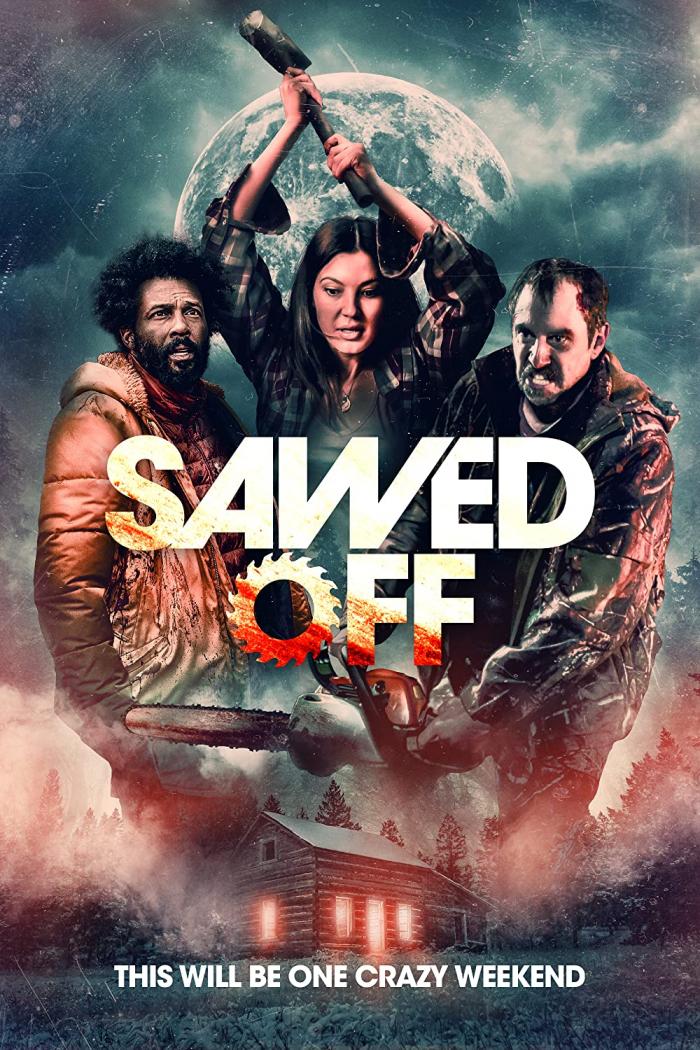You are here
Home › Movies › Familiarity Doesn't Destroy Millman Productions/Sandaled Kid Productions Latest Horror Effort 'Sawed Off' ›Familiarity Doesn't Destroy Millman Productions/Sandaled Kid Productions Latest Horror Effort 'Sawed Off'
FTC Statement: Reviewers are frequently provided by the publisher/production company with a copy of the material being reviewed.The opinions published are solely those of the respective reviewers and may not reflect the opinions of CriticalBlast.com or its management.
As an Amazon Associate, we earn from qualifying purchases. (This is a legal requirement, as apparently some sites advertise for Amazon for free. Yes, that's sarcasm.)

It's been said that, creatively speaking, there are no new ideas. To a certain extent the hypothesis is valid: every artistically inclined soul, whether they be a painter, sculptor, musician, writer or filmmaker, is only the sum of one's individual tastes in their given medium. Just as Plato was influenced by his mentor Socrates, so did Plato's philosophical musings mold his own student Aristotle; blues guitarist Muddy Waters impacted early rock gods Eric Clapton and The Rolling Stones, who in turn impressed future generations of musicians; even weird-lit icon H.P. Lovecraft, whose inspiration affected untold imaginative minds, was self-admittedly a product of boyhood admiration for Edgar Allan Poe and Lord Dunsany. In this theory of artistic evolution what appears to be innovation (the abstract art of Marcel Duchamp or Picasso, for instance), is merely an opposing reaction against previous established trends rather than any stylistic revolution. Even Shakespeare's plays openly owe debt to the works of his forbearers, critics correctly assert.
Perhaps due to its highly visual nature (or, more likely, a desire to turn profits by jumping on the nearest passing bandwagon), cinema has always readily borne influence on its sleeve, and nowhere is that more apparent than in horror. Oftentimes viewed as a creatively stagnant genre, the amount of influence certain films exert is staggering: how many umpteen zombie apocalypses did George A. Romero unleash with Night of the Living Dead? And would a legion of teenage-murdering masked movie madmen exist without John Carpenter's seminal The Shape from Halloween (itself influenced by Hitchcock's Psycho)?
When director Sam Raimi and a small cadre of plucky actors (including Raimi's college bud Bruce Campbell), retired to a remote cabin in the Tennessee backcountry to lens 1981's now nearly-mythic The Evil Dead, they too were starting something that can be seen in films such as Millman Productions/Sandaled Kid Productions' latest, Sawed Off.Sharing the aforementioned motion picture's isolated location, tight cast and supernatural shenanigans, the plot centers on beleaguered Jon (co-writer and co-producer Jody Barton), who's returned to his rural hometown after years away at the behest of former flame Marjorie (Eva Hamilton). Jon's childhood friend, Frank (Trae Ireland), who took the role of Marjorie's beau after Jon's city-bound departure, accompanies him to the rustic abode Marjorie inherited from her late father for a weekend hunting trip, but from the onset there's trouble: odd occult scribblings mark the upstairs walls, Jon experiences vivid hallucinations, and Marjorie warns both men the land suffers from a grisly indigenous curse. Events take a turn for the genuinely bizarre, however, when Jon accidentally shoots and kills Frank as they're out deer stalking, only to later discover his friend alive (or is he?) and angry back at the cabin. Thus begins an outlandish Groundhog's Day loop of murder, with Jon and Frank caught in an ever-escalating game of one-upmanship, killing each other only for the clock to reset once they die. And as the storyline skews further into strangeness, the questions arise: are Jon and Frank dead? Undead? What part does the legend of the Living Woods have to do with the increasing craziness? Or is it all just a figment of Jon's deteriorating mental state?
True to the previously cited creative theory, there's literally nothing in Sawed Off that hasn't been done before; every aspect, from the love triangle to the desolate cabin and Native American curse, the otherworldly possession, the black humor and repetitive time-loop scenario, has graced silver screens at some past point. Yet, like Aristotle or Lovecraft or Shakespeare, a familiarity with its influences doesn't conspire to make Sawed Off any less entertaining. Quite the opposite; the atmosphere is foreboding, the directing by Hunter Thompson is suitably tense, with a fractured, non-linear narrative that intrigues as much as it perplexes. Sawed Off is a continuum-shattering thousand-piece cinematic jigsaw puzzle that unlike so many brain-dead teen slashers actually requires rapt viewer attention. Rather than dodge the obvious Raimi influence, the script by Barton, Johnson and Chuck Wagner instead revels in bloody Ash Williams-level mischief, and a dedicated Deadite devotee can quickly spot the freely-dropped references: Marjorie's early use of a chainsaw, the sentient wilderness, the grotesque makeup effects. Sawed Off is a complex valentine to that celebrated emblem of grueling '80's terror, with a bit more modern polish and an affection that elevates what could've easily become derivative schlock in lesser hands to lovingly rendered homage. When the ultimate mayhem is finished and that final time-twisting reel plays, it becomes clear that Sawed Off is more than the sum of its collective celluloid parts, and it's for that reason that I grant it a 4 (out of 5) on my Fang Scale. Surprisingly enjoyable.


